Report of the Department of Justice on April 12, 2023 Use of Force by Wilmington Police Department
Scope of Investigation
This is the final report of the Delaware Department of Justice, Division of Civil Rights and Public Trust (“DCRPT”), arising out of the investigation into the use of deadly force – a single, non-fatal gunshot – by the Wilmington Police Department (“WPD”) against Billy Burton. Jr. (“Burton”). DCRPT investigators and attorneys reviewed evidence consisting of video footage, dispatch records, victim and witness interviews, police interviews, scene photos, and medical records.
This DCRPT report relates to a case involving a pending criminal defendant. As our reports seek to expand transparency and ensure trust in the process of reviewing the deadly use of force by law enforcement, we must stress that this report is wholly separate from the criminal proceeding – DCRPT’s investigators and prosecutors are not involved in the criminal case, nor are Criminal Division prosecutors involved in DCRPT’s decision-making. The outcome of Burton’s criminal case must be determined solely and exclusively on the evidence presented at trial, and in accordance with the Court’s rules. This report in no way relieves the State of Delaware of its burdens at trial.
Purpose of the Department of Justice Report
The Department of Justice determines whether a law enforcement officer’s use of deadly force constitutes a criminal act. The Department of Justice does not establish or enforce internal police policies concerning the proper use of deadly force by law enforcement officers. Law enforcement agencies are responsible for establishing and enforcing guidelines for the use of force by their officers and for determining whether an officer’s actions were consistent with such guidelines in a given case. This report expresses no opinion whether involved officers’ actions complied with departmental policies or procedures.
Facts
At approximately 8:43 a.m. on Wednesday, April 12, 2023, a resident of 604 S. Heald Street, Wilmington called 911 to report that her son, Billy Burton, was harming himself with a butcher knife. The caller stated that Burton had stabbed himself in the chest with the knife. Officers Sean Cannon (“Ptlm Cannon”) and Simeon Crocker (“Cpl. Crocker”) arrived on scene and Burton’s mother met them at the front door of the residence. She told the officers that Burton was on the second floor. The officers asked her and her husband to wait outside, but the husband went upstairs to lock up their dog.
Cpl. Crocker was the first officer to the top of the stairs leading to the second floor. The husband, who identified himself as Burton’s father, was also upstairs and standing near Cpl. Crocker. Burton emerged from a bedroom down the hall holding up his shirt, exposing his wound with one hand and holding a knife in the other hand. Cpl. Crocker and Burton’s father commanded Burton to put the knife down, but Burton continued to hold the knife and move toward Cpl. Crocker and Burton’s father. Cpl. Crocker fired one shot at Burton, striking him in the upper thigh area. Burton was then detained by officers. EMS provided aid to Burton on scene and transported him to Christiana Hospital where he was treated for numerous internal injuries as a result of the self-inflicted stab wounds. Burton was also treated for the gunshot wound.
Statement from Officer who Used Force
Corporal Simeon Crocker
Corporal Simeon Crocker told investigators that on April 12, 2023, he was assigned to patrol. Cpl. Crocker was in full uniform and driving a marked WPD patrol vehicle. Cpl. Crocker was equipped with a Body Worn Camera (“BWC”); however, he did not activate it during the interaction with Burton. Cpl. Crocker has been with the WPD for over 17 years. He was recently assigned to the Patrol Division which includes use of a BWC.
Cpl. Crocker was dispatched to 604 S. Heald Street for a suicidal subject that was armed with a knife and cutting himself. Cpl. Crocker stated that he had never been to 604 S. Heald Street or previously contacted any of the residents. Patrolman Cannon was also dispatched to the call and arrived shortly after Cpl. Crocker. Cpl. Crocker opened the gate to the porch of the residence and drew his weapon. As they were approaching the residence, Cpl. Crocker and Ptlm. Cannon confirmed with each other the nature of the complaint. Cpl. Crocker stated that he drew his weapon because the suspect, Burton, was said to be armed with a knife and had a mental health history. Cpl. Crocker wasn’t sure what kind of situation they were walking into.
Cpl. Crocker knocked on the partially opened door, then fully opened it. The officers were greeted by a female (later identified as Burton’s mother) who had her cell phone in her hand. Cpl. Crocker asked the female where Burton was located. She stated that Burton was upstairs and had cut himself. Cpl. Crocker asked which room Burton was in and the female pointed upwards. The female confirmed that Burton still had a weapon. The officers asked her to step outside. Cpl. Crocker could hear a television upstairs but couldn’t see the suspect. Cpl. Crocker and Ptlm. Cannon proceeded up the stairs towards the second floor while scanning the area. Cpl. Crocker saw three rooms, two of which had closed doors and one of which, straight back, had the door open. As he went up the stairs, he turned around and saw another open room (toward the front of the house). At this point, he could see Burton standing in that open room, in front of a television. Cpl. Crocker could not see whether Burton had anything in his hand at this time.
Cpl. Crocker described Burton as a Black male with a large build, an afro, and cuts on his body. Burton was facing Cpl. Crocker. Ptlm. Cannon was still behind him on the stairs. Cpl. Crocker stated that when he got to the top of the steps, a pit bull came out of the room where Burton was and towards the stairs. Cpl. Crocker went back down the stairs to avoid the dog until another male (later identified as Burton’s father) came out of one of the upstairs rooms and put the dog away. Cpl. Crocker came back up the stairs and placed himself between Burton and Burton’s father. Cpl. Crocker saw that Burton was pointing a knife, which Crocker later described as a longer than average kitchen knife, at him. Cpl. Crocker reiterated to investigators that he put Burton’s father behind him as Burton started to walk out of the room. Cpl. Crocker was positioned at the top of the stairs.
Cpl. Crocker stated that Burton was coming toward him, and he gave commands for Burton to put down the knife. Cpl. Crocker stated that Burton’s father, who was still behind him, was also telling his son to put down the knife. Burton’s only response was to grunt and continue moving forward. Cpl. Crocker noticed Burton raise the knife up as he moved down the hallway. Cpl. Crocker and Burton’s father began to back up to create additional space; however, Burton continued to steadily walk toward them with the knife in hand. Cpl. Crocker continued to give commands to drop the knife. As Burton got within five feet of Cpl. Crocker, Cpl. Crocker again asked him to please put the knife down. Cpl. Crocker advised that he raised his weapon. Cpl. Crocker fired at Burton when he was approximately three feet away.
Cpl. Crocker said that when he fired, Burton was still coming towards him, had the knife in his hand with his arm was extended out, and the knife pointed in his direction. Cpl. Crocker did not think Burton was going to stop because he did not listen to any commands and his knife stayed in the same position. Cpl. Crocker stated that he was thinking about whether Burton would begin to run full force with the knife or if he was going to fight. Cpl. Crocker was worried about his safety as well as the safety of Burton’s father because of the close distance. Crocker believed the subject was going to stab him.
When Cpl. Crocker fired, he stated that he could see Ptlm. Cannon on the stairs. Cpl. Crocker could see Burton coming at him and was focused on that. Cpl. Crocker stated his backdrop was clear when he fired his weapon. He fired one round because he was trying to incapacitate the suspect, and after he fired the suspect dropped the knife and fell to the floor. According to Cpl. Crocker, one round had the intended effect, and he did not fire any additional rounds. After a brief struggle, officers were able to place Burton in handcuffs. EMS responded to the scene to initiate treatment, and Cpl. Crocker was removed from the scene.
Cpl. Crocker stated that his training and experience as a Taser instructor and his field experience with the Taser played into his decision. He considered using the Taser but did not because he thought it would not be effective on Burton. Cpl. Crocker questioned the effectiveness of the Taser due to Burton’s mental state. Cpl. Crocker also did not know whether Burton was on any type of substance and remarked how close Burton was to him (and therefore how difficult it would be to react in defense). When he fired, Cpl. Crocker did not believe any other option would stop Burton from advancing and felt that if he had not fired the suspect would have continued to advance on him.
Police Witnesses
Corporal Brandon Payne
On April 12, 2023, Corporal Brandon Payne (“Cpl. Payne”) responded to 604 S. Heald Street for a report of a stabbing in progress where a male was harming himself with a knife. He had not responded to this address before. When Cpl. Payne arrived, Ptlm. Cannon and Cpl. Crocker were already inside the residence, and EMS were arriving. Cpl. Payne made contact with a female inside the residence and asked her to leave as he could hear Cpl. Crocker commanding someone to drop the knife. Cpl. Payne could also hear an unknown voice make additional verbal commands.
Cpl. Payne made contact with Ptlm. Cannon, who was behind Cpl. Crocker near the top of the stairs, via radio. Cpl. Payne was on the first floor and could barely see that there was another man next to Cpl. Crocker. Cpl. Payne stated that he could not see the subject (Burton). Cpl. Payne asked Ptlm. Cannon to report what was going on via radio. Ptlm. Cannon moved down the stairs to make a radio transmission and called in that shots were fired after Cpl. Crocker fired his handgun. The knife fell down the stairs through the hallway/stair railing.
Cpl. Payne made his way to the second floor, where he saw Burton lying face down on the hallway floor. Burton’s right arm was tucked underneath him. Per Cpl. Payne, Burton did not seem to understand commands to show his hidden hand. Burton resisted officers with his free arm. Burton was conscious and alert when placed into custody and did not make any statements. Once Burton was removed from the residence, Cpl. Payne went downstairs and out to the porch.
Patrolman Sean Cannon
On April 12, 2023, Ptlm. Cannon was dispatched to 604 S. Heald Street with Cpl. Crocker for a report of a suicidal subject (Burton) who stabbed himself and was bleeding heavily from the chest. The report indicated that Burton was armed with a butcher knife. Ptlm. Cannon and Cpl. Crocker arrived at the residence at the same time. Ptlm. Cannon had not been to this address before.
At first no one responded at the door and Ptlm. Cannon requested a call back.
A black female then answered the door, and the officers entered the house. The female told officers that the Burton was still armed with a knife and that the officers were going to have to shoot him. Ptlm. Cannon followed Cpl. Crocker upstairs to locate Burton. As they went up the stairs, a dog came out of an upstairs room. The dog seemed aggressive, and Ptlm. Cannon backed down the stairs. He reported the dog over the radio then proceeded back up the stairs. Burton came out of the same bedroom that the dog came from. At this point Ptlm. Cannon believed Cpl. Crocker was at the top of the stairs.
Another male, who said he was Burton’s father, entered the house and went up the stairs to secure the dog. Burton’s father then remained behind Cpl. Crocker near the threshold of the bedroom at the top of the stairs. Burton was covered in blood and not responding to Cpl. Crocker’s commands to put down the knife. He recalls Cpl. Crocker giving clear commands at least two to five times.
Ptlm. Cannon moved back down the stairs to report the events over the radio. He later told an investigator that he was unsure whether Burton noticed him on the stairs. Burton continued to move down the hall towards Cpl. Crocker, despite the commands given. Ptlm. Cannon was downstairs in the living room when Cpl. Crocker fired at Burton. He could not see Cpl. Crocker or Burton at this time. Ptlm. Cannon stated that one shot was fired. The knife fell to the first floor. Ptlm. Cannon proceeded up the stairs behind Cpl. Payne to help get Burton into custody. Ptlm. Cannon observed Burton lying face down on the floor. Burton’s left arm was out, but his right arm was under him. The officers were giving Burton verbal commands and Ptlm. Cannon used his right knee to strike Burton’s shoulder and get his right arm out from under him. Ptlm. Cannon heard Burton grunt but did not hear him make a statement. After Burton was removed from the residence, Ptlm. Cannon went downstairs into the living room.
Civilian Witnesses
Witness One
Witness One advised that he lives at 604 S. Heald Street with his wife and son, Burton. According to Witness One, Burton was hallucinating and saying that he was seeing people in his windows and bedroom for a few days. Witness One told investigators that this happens when Burton does not take his prescribed medication. Witness One advised that Burton was diagnosed with schizophrenia approximately ten years ago and is currently under a doctor’s care. Burton is prescribed a number of medications that he had not taken in two to three days. Approximately one month prior, Burton attempted to jump off a bridge near their residence. Witness One stated that Burton has no issues when he takes his medicine.
Witness One said that on April 12, 2023, he fell asleep around 3:00 to 4:00 a.m. when Burton called for an ambulance and said that his mother was bleeding. Witness One told Burton that his mother was not bleeding. An ambulance arrived and Burton was transported to Wilmington ER for an evaluation. Shortly thereafter, Burton’s mother responded to the Wilmington ER to pick up Burton. They got back to the house around 5:00 a.m. The hospital ER gave Burton a paper and directed him to go to Meadowood Center; however, according to Witness One, whenever Burton is taken there, he refuses to get out of the car and promises to resume taking his medication if he is taken home.
When Burton returned from the hospital, he was talking to himself, and was peeking out of and saying people were at the windows. Witness One left for work. Witness One’s wife then called and said Burton had a knife and was stabbing himself in the stomach and the chest. Witness One told his wife to call the authorities and to get out of the house. Witness One decided to leave work. When Witness One got home, two officers were going into the house.
Witness One told his wife to get out of the house. Witness One stated the two officers were in front of him on the stairs and that one of the officers stated that his son had a knife. One of the officers came back down the stairs. When Witness One got upstairs he put the dog away, and he saw Burton in the front bedroom down the hallway. Burton had blood on him and was in possession of a long butcher knife.
The officers began telling his son to put down his knife. Witness One told his son that the police were not joking, and he was going to be shot. One of the officers pushed Witness One back. Witness One again said he told his son he was going to get shot. Witness One stated that his son came from the bedroom into the hallway and the Black officer gave his son commands to put down the knife. Burton then came after the officer and lunged at him. Witness One stated that Burton made a mean face and did not seem to care whether he got killed. According to Witness One, Burton was at the door with the knife and had come all the way down the hallway. Witness One stated that his son was trying to stab an officer. The officer fired and his son fell to the floor. The officers kept giving commands to put the knife down and had to pry the knife out of Burton’s hand.
Witness One further stated that Burton had previously tried to stab him approximately one and a half months ago.
Physical Evidence
Injuries
Burton was treated for numerous self-inflicted stab wounds which caused a variety of serious internal injuries along with a gunshot wound to the left upper thigh.
Body Worn Camera
Ptlm. Cannon and Cpl. Payne were both equipped with BWCs which were activated during the April 12, 2023 incident at 604 S. Heald Street. Ptlm. Cannon’s BWC shows Burton’s father passing by him to go upstairs and Ptlm. Cannon proceeding after him. Commands from at least two different voices to put the knife down, and a dog barking, can be heard. As Ptlm. Cannon is near the top of the stairs, Burton appears in a doorway. Burton has his shirt lifted and a wound can be seen near his chest. A knife can also be seen in Burton’s hand. A dog runs into the hallway and Ptlm. Cannon takes a few steps down the stairs. A single gunshot is then heard. Cpl. Payne’s BWC footage shows that Cpl. Payne entered the residence. Commands to the put the knife down and a dog barking can be heard prior to a gunshot while Cpl. Payne is on the first floor of the residence.

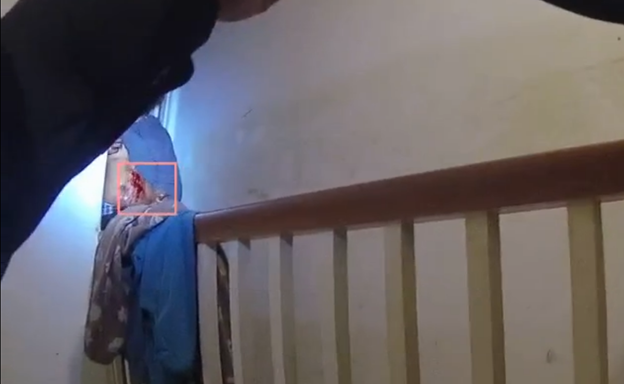
Crime Scene Photos
The location of the incident is the residence of 604 S. Heald Street, Wilmington, Delaware.
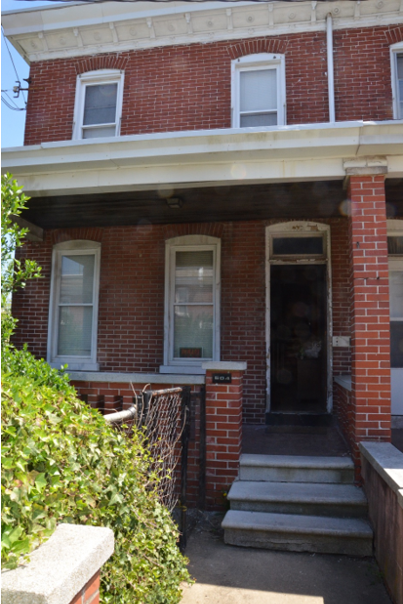
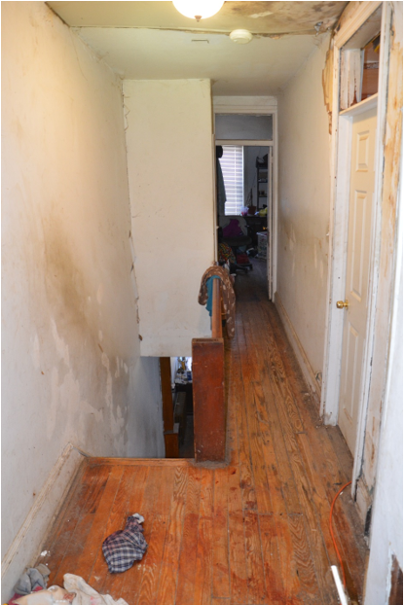

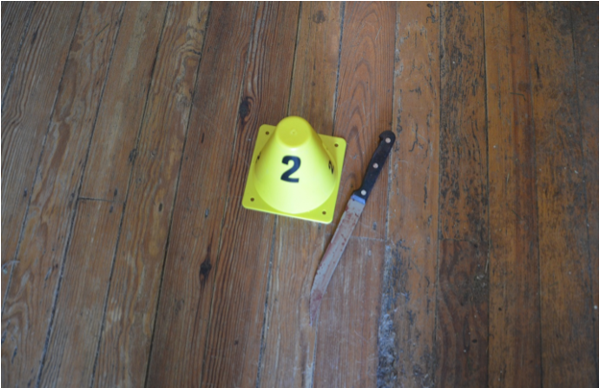
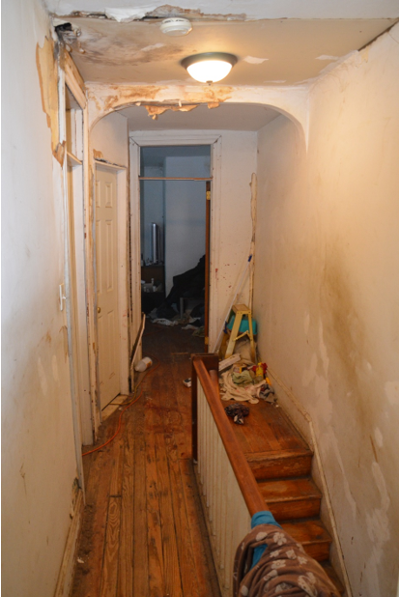
Conclusion
The State must determine whether Cpl. Crocker’s use of deadly force constitutes a criminal act. Title 11 Section 464 of the Delaware Code defines the legal use of force in self-protection. It provides, in pertinent part, that “[t]he use of deadly force is justifiable under this section if the [officer] believes that such force is necessary to protect the [officer] against death or serious physical injury.” In a criminal case, the State must also prove beyond a reasonable doubt that an officer’s use of deadly force was not justified under Title 11 Section 465, use of force for the protection of other persons.1
Under Delaware law, the objective facts and circumstances must be considered when determining whether the use of force was justifiable against another person, either in self-defense or in the defense of others. The specific factual inquiry is two-pronged. The first question is whether the officer reasonably believed, at the time they intentionally fired their weapon, that such action was necessary to protect themselves or others from death or serious physical injury. The second question is whether the officer was reckless or negligent in having such belief, or in acquiring or failing to acquire any knowledge or belief, which is material to the justifiability of the use of force. 2 If such force is determined to have been justified, the law requires an examination into whether such force negligently or recklessly created injury or risk of injury to innocent third parties pursuant to 11 Del. C. § 470(b).
In this case, the use of force by police was justified as a matter of law in both self-defense and in the defense of others. Cpl. Crocker was not reckless or negligent in forming the belief that deadly force was immediately necessary. On April 12, 2023, Cpl. Crocker responded to 604 S. Heald Street due to a report of a male harming himself with a knife. When Cpl. Crocker reached the second floor of the residence, he was faced with Burton, armed with a knife and suffering from a number of self-inflicted stab wounds. Despite repeated commands to drop the knife from Cpl. Crocker and Burton’s father, Burton advanced toward Cpl. Crocker and his father with the knife.
Because Cpl. Crocker was justified to use force pursuant to 11 Del. C. § 464, we further determine that he was not negligent or reckless in injuring or creating a risk of injury to third persons under 11 Del. C. § 470(b). Cpl. Crocker moved in front of Burton’s father in an effort to protect him from Burton, and there were no additional persons on the second floor near Burton at the time Cpl. Crocker fired. No third persons were injured by the police and the police took reasonable measures to only use force when necessary.
Finally, 29 Del C. § 2553(a)(3)(b) requires as a matter of law that if DCRPT issues a public report on the use of force, the report must include the race of the law enforcement officer who used force, the race of the individual on whom force was used, and whether race was a relevant or motivating factor. Burton is a Black male. Cpl. Crocker is a Black male. Race was not a relevant or motivating factor in the use of force.3 The relevant and motivating factors in Cpl. Crocker’s use of force was the reasonable belief that force was necessary due to the imminent danger and substantial risk of death/serious injury that Burton posed to officers and others.
Upon careful consideration of the available evidence and the application of expert opinion to that evidence, Cpl. Crocker reasonably believed that the use of deadly force against Burton was immediately necessary for the purpose of protecting another – and himself. As a result, the Department of Justice concludes the use of deadly force in this case does not constitute a criminal offense under the laws of the State of Delaware.
Notes
1 “(a) The use of force upon or toward the person of another is justifiable to protect a third person when: (1) The defendant would have been justified under § 464 of this title in using such force to protect the defendant against the injury the defendant believes to be threatened to the person whom the defendant seeks to protect; and (2) Under the circumstances as the defendant believes them to be, the person whom the defendant seeks to protect would have been justified in using such protective force; and (3) The defendant believes that intervention is necessary for the protection of the other person.”
2 11 Del. C. § 470(a).
3 If race were a relevant or motivating factor in any shooting, the criminal charging analysis would include discussion of Hate Crimes under 11 Del. Sec. 1304(b).
Supplements & Downloads
Documents
Report of the Department of Justice on April 12, 2023 by Wilmington Police Department
Videos
Viewer discretion advised. Because of their graphic nature, these videos are age-restricted.
Video: Body-worn camera footage from Ptlm. Cannon
Video: Body-worn camera footage from Cpl. Payne




